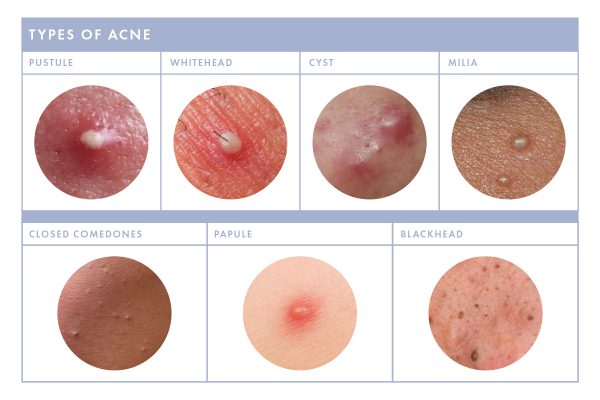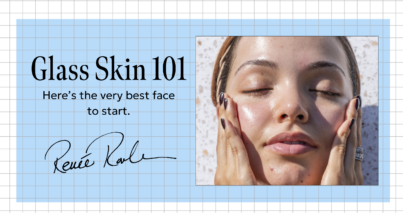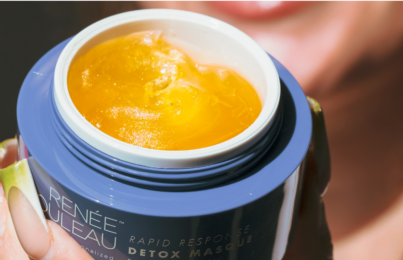Updated 8/5/18. All types of acne and blemishes are not equal. Whiteheads are a type of small blemish that comes and goes fairly quickly. In this post, I’ll first explain exactly what whiteheads are (and are not!) and then will go into how to treat them. With my expert tips, your skin can be clear and bump-free in no time.
Whiteheads are best described as infected, white bumps on the face but are not milia.
There is a lot of confusion as to what “whiteheads” really are. Whiteheads are small blemishes caused by Propionibacterium acnes (P. acnes) bacteria. They don’t have much redness or pain when touched, unlike a papule, pustule, or cyst. When they begin, the infection comes to the surface fairly quickly and forms a white-colored head. When squeezed, the pus pops out easily (usually on the first try) and not much scarring or redness is left behind. Of all the types of blemishes where the infection works its way to the surface of the skin, whiteheads are the easiest to deal with because the life cycle is fast.
It’s important to know that whiteheads that look like white bumps on the face are not milia. Milia, as you can see in the above photo is considered to be a non-inflammatory lesion. Meaning, they are like hard whiteheads on the face but aren’t actually whiteheads. Milia is often found on the upper cheeks or around the eyes and needs to be removed by a dermatologist or skilled esthetician.
Whiteheads are different from pustules.
Additionally, a lot of people get whiteheads confused with regular blemishes. In the photo above, you might think a whitehead looks a lot like a pustule. There are similarities in that they both have visible pus on the surface. However, whiteheads have less infection around them so the raised part of the face is usually just the whitehead. Versus with a pustule, you can see that not only is the whitehead protruding from the skin to make a bump but also all of the area around it, too. Simply put, a whitehead is a small bump that can be easily popped and removed (oftentimes without any blood coming along with it) and a pustule is a larger, raised bump that will be painful and when squeezed can ooze with blood.
Common causes of whiteheads:
Oily skin
Those with oily skin are going to be more likely to get whiteheads since the underlying cause of whiteheads comes from oil. (Oil breeds bacteria and bacteria leads to whiteheads.)
How to prevent whiteheads: Just like with any clogged pores, bumps, and blemishes, these all stem from having oily skin.
Exfoliating products
Sometimes if you’re new to using exfoliating acids (products with glycolic, lactic, and salicylic acids), the skin can get some whiteheads as it rearranges your skin’s cell turnover process. This can be called a “purging” process as trapped oils are being released due to the removal of surface dead skin cell buildup. Generally, this is short-lived and will go away as your skin gets used to regular exfoliation.
How to prevent whiteheads: When introducing exfoliating acids, facial scrubs, or at-home skin peels, take it slowly. If a peel says to leave it on for 10 minutes, only leave it on for two minutes. When using a facial scrub, massage it across the skin without applying much pressure so as not to aggravate the skin. If an exfoliating acid says to use it every night, start with using it just once a week. It’s all about baby steps with exfoliants until your skin gets used to them.
Hair removal such as waxing or threading
These methods of hair removal can cause the skin to purge into whiteheads so a lot of people just learn to accept it because they have no other choices for removing the hair.
How to prevent whiteheads: After removing the hair, immediately apply ice for ten minutes and then follow with a light layer of cortisone cream. This combination may help calm the inflammation that leads to whiteheads.
Moisturizer
Some moisturizers, even if it doesn’t feel particularly heavy, can have a high concentration of oils and emollients. This may block some of the pores and lead to the production of whiteheads.
How to prevent whiteheads: You always want to use a moisturizer for your skin type. (Skin types #1, #2, #3 and #4 are skin types that produce oil.) If you’re feeling tight or dry and need additional moisture, you’re better off applying a skin serum underneath to give a boost of hydration.
Liquid foundations
For some combination and oily skin types, the ingredients used in liquid foundation makeup can create a blockage in the pore-lining which leads to an infection. This can cause whiteheads to appear on the face.
How to prevent whiteheads: Switch to a powder foundation or try a different liquid foundation. A lot of times, it’s just trial and error.
Makeup primers
These “base coats” for making pores appear invisible under foundation makeup are really popular now but can act similar to liquid foundations by blocking the pores.
How to prevent whiteheads: As much as possible, try to limit their use to special occasions. Primers can contribute not only to whiteheads but also to clogged pores, bumps which lead to a bumpy texture for the skin.
Heat
Heat, such as from being outside on a hot summer day, increases sudden oil production. When the pore has too much oil trying to get through the opening, whiteheads can start up.
How to prevent whiteheads: Try to cleanse your skin as soon as possible once you get indoors to remove way any heat-induced oil. Be sure to apply toner and moisturizer afterward as you never want to leave your skin bare after cleansing. This can quickly lead to dehydration which can put your skin out of a healthy balance.
How to know if a face product is the cause of your whiteheads?
If you just started using a new product and within the first few days, you suddenly get a small cluster of 3-4 whiteheads in one area. This might be an indication that it was from something new that you applied topically. Why do whiteheads sometime appear in a certain area when you applied a new product to the entire face? More than likely, it’s because there already was some sort of blockage or disruption of oil flowing through the pore lining that erupted when something new was introduced.
How to get rid of whiteheads under the skin.
Step 1: After cleansing the skin, gently squeeze out the infection.
Once whiteheads appear on the very surface of the skin, they are very easy to pop out. Simply gently squeeze out the infection with your fingers wrapped in tissue. While some experts may cringe at the thought of me instructing people to squeeze at their faces, this can be very safe if done correctly. And in reality, no one wants to walk around with have whiteheads on their skin, right?
Step 2: After removal, apply a non-drying, antibacterial mask to disinfect the pores.
The skin will greatly benefit from using a gentle antibacterial mask that will get into the pores to ensure they stay clean. I recommend Rapid Response Detox Masque to all of my clients prone to whiteheads, clogged pores, and bumps. It uses a popular ingredient called salicylic acid which works its way into the pores lining to prevent oil blockage. Additionally, it offers other soothing benefits for calming and clearing the skin. Note: Clay masks aren’t very effective for doing this.
In summary…
Whiteheads: white bumps on the face that are not milia but rather an infected type of blemish that secretes white pus up and out through the surface of the skin. I’m often asked about how to get rid of whiteheads under the skin that appear often? A mask like Rapid Response Detox Masque can be used as often as every day to help prevent whiteheads from appearing in the first place—no matter what the cause.
Celebrity Esthetician & Skincare Expert
As an esthetician trained in cosmetic chemistry, Renée Rouleau has spent 35 years researching skin, educating her audience, and building an award-winning line of products. Her hands-on experience as an esthetician and trusted skin care expert has created a real-world solution — products that are formulated for nine different types of skin so your face will get exactly what it needs to look and feel its best. Trusted by celebrities, editors, bloggers, and skincare obsessives around the globe, her vast real-world knowledge and constant research are why Marie Claire calls her “the most passionate skin practitioner we know.”





Comments:
Excellent! Ice works, too! -Lydia
Posted By: Lydia Noel |
Hi, Renee. The red bumps are some sort of inflammation. I put some ice on them last evening, and they calmed. 🙂 Also, thank you to Renee and Lydia for responding to both of my inquiries.
Posted By: Marcy |
As for papules, you can look for one that doesn’t contain that. But a one or two time use probably won’t be a problem.
-Lydia
Posted By: Lydia Noel |
It’s really hard to say without seeing it. If they are always there and never go away, then it’s some sort of skin growth and should be looked at by a dermatologist.
Posted By: Renée Rouleau |
Two more things:
I read up on cortisone injections. Apparently, the pimple disappears, but is replaced by a sort of dent which can take months to heal and fill in.
Also, you recommend cortisone cream for papules, but it contains petrolatum and mineral oil, which you recommend one should avoid using on the skin.
I would appreciate your comments re: the aforementioned.
Posted By: Marcy |
What about small, red, raised bumps, which aren’t painful? What are these?
I have a few on my cheek.
Posted By: Marcy |
Hi Marcy,
Answer to #1
The real cause is truly unknown as to why you get them in that area. We suggest to cut out your dairy (a previous blog post discusses that) but could also be hormonal.
Answer to #2
Yes, it will be slightly painful as they are injecting a needle into a very painful cyst. Once they inject the cortisone, it should be gone within 24 hours. One injection for one cyst.
Posted By: Renée Rouleau |
I am plagued most often by whiteheads, especially around the mouth/lip area – very painful, pustules and cysts. That said, the severity and frequency of all of the aforementioned have been greatly reduced since using your product line, Renee. 🙂
Renee – two questions:
1. Would you talk about why whiteheads/pimples form on the mouth/lip area?
2. Are cortisone injections very painful? And, does one have to undergo a series of injections, or just one? I don’t think I’m at the point where my cystic acne is so severe to warrant cortisone injections, but, since you have mentioned them, I thought I’d ask.
Posted By: Marcy |
For simplicity sake (and because we couldn’t fit a sixth one in the header!) we kept it to the five. But since you mentioned papules, let me talk about those.
Papules: It’s the next stage past a closed comedone (whitehead) where bacteria has caused inflammation and infection resulting in a painful, red blemish. The main difference between a papule and a pustule is that pustule is the next stage where dead bacteria and dead skin cells rise to the surface causing yellow pus.
What you can do: The main symptom of a papule is inflammation and irritation so the goal is not to dry it out with acne products but rather to calm down the inflammation by using topical cortisone cream (found at the drug store) and ice compresses followed by a soothing mask like Renee Rouleau Azulene Gel Mask. These both will reduce the inflammation.
Posted By: Renée Rouleau |
You forgot papules. I get those a lot. I actually have all of the above acne but I frequently get papules more than I do cysts
Posted By: Molly |